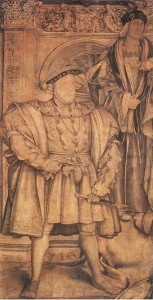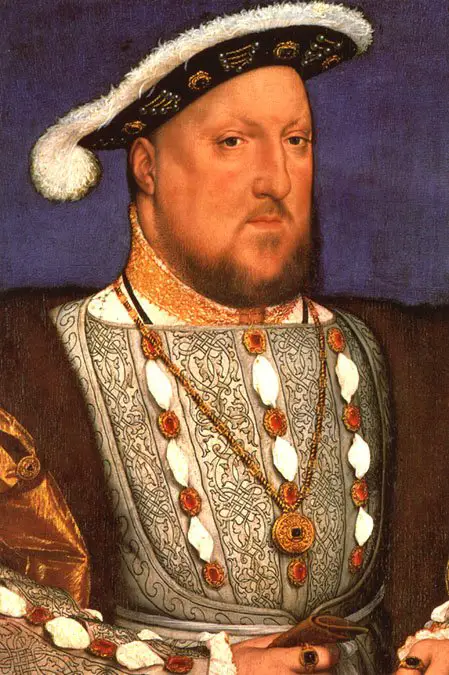
On this day in history, in the early hours of 28 January 1547, fifty-five year-old Henry VIII died at Whitehall Palace.
Archbishop Thomas Cranmer was at the King’s side when he died, although Henry had lost the power of speech by the time her arrived. Cranmer asked Henry to give him some sign that he trusted in God and Henry “holding him with his hand, did wring his hand in his as hard as he could” and then he slipped away. He had reigned for over 37 years.
His nine-year old son, who was now King Edward VI, was informed of his father’s death by Edward Seymour and Anthony Denny on 29 January and was proclaimed king on 31 January. Edward was crowned king on 20 February 1547 at Westminster Abbey.
You can read all about Henry VIII’s last days, his burial and his will in my article 28 January 1547 – Henry VIII Dies, but for now I’ll leave you with historian David Starkey’s words on the paradox that is Henry VIII – the “virtuous prince” and “hulking tyrant”:
“Holbein’s Henry is the king of his last dozen or so years, when he was – in Charles Dickens’s glorious phrase – a spot of blood and grease on the history of England. This is the hulking tyrant with a face like Humpty Dumpty of nightmare, who broke with Rome and made himself supreme head of the church; who married six wives, of whom he divorced two and divorced and executed two others; who dissolved six hundred monasteries; demolished most of them and shattered the religious pieties and practices of a thousand years; who beheaded nobles and ministers, including those who had been his closest friends, castrated, disembowelled and quartered rebels and traitors, boiled poisoners and burned heretics.
This is also the king who reinvented England; presided over the remaking of English as a language and literature and began to turn the English Channel into the widest strip of water in the world. He carried the powers of the English monarchy to their peak.”
I highly recommend Starkey’s Henry: Virtuous Prince, which looks at Henry VIII’s early reign and shows a very different side to this iconic king.
Trivia: The iconic image we have of Henry VIII – full length, looking forward, hands on hips, legs astride etc. – is based on Holbein’s cartoon/sketch (shown above) for the Whitehall mural, which was destroyed by fire in 1698. The portrait that is actually by Holbein is this one, which is on display in Madrid’s Thyssen-Bornemisza Museum:

Notes and Sources
- Henry: Virtuous Prince, David Starkey
- Detail from the cartoon of Henry VIII – http://commons.wikimedia.org/wiki/File:Henry_VIII_and_Henry_VII,_by_Hans_Holbein_the_Younger.jpg
we can say many bad things about Henry but he did what he had to do for this country ! He thought he was right even if we don’t agree not the only tyrant king there was many others far worse than him they lived in cruel times ! He wasn’t a great king but what a fascinating yet small period of history that will be a topic of debate for many more yrs to come what would we have done with out him !!!
He made his mark on history and there will never be another like him.
Thank God there will never be another like him to reign over England!
Isn’t it strange how he died how his father’s birthday.But no matter what he has definitely captured people’s imaginations and retained a sort of immortality.It’s rather sad actually when you think about all the potential he had in the beginning.
Rest in peace, Great Harry, greatest monarch England ever had. Four portraits were made from the Whitehall Mural which was destroyed, either from the school of Holbein or by Vol win, historians state different things, but the best and most famous is the property and can be seen here in Liverpool at the Walker Art Gallery. The other three vary slightly and are in different places, normally on tour. One other copy, although not quite the same is in Petworth in Surrey, another Hampton, and a similar one in the portrait gallery. Numerous copies popped up from the original cartoon, but all show one thing, this is not a true gage of the width of the King, but a deliberate exaggeration to show the fierce majesty of a King who was in more ways than one , larger than life.
Henry was a man of two halves, a King of duel sides, a complex person who only comes into his own ironically towards the end of his turbulent and passionate relationship with Anne Boleyn. 1536 is the defining moment in Henry’s reign. Both for good and ill it is this year that sees his decision making process change. From the crisis of his accident, the tragic loss of his son, the turbulent days which led to the execution of Anne and five intimate members of the inner court, through the dangers posed by the rebellions in the north and Midlands, emerged a King who was more decisive, stronger and dangerous. Henry made decisions that would set England and Wales in the modern age, he was more advanced in his thinking, but Brookes no opposition or interference, set about our national defences, changed the face of monarchy, gave kingship a true veneer of majesty, and set about on some of his real achievements. It was in the next decade that Henry became the man of power and myth he had seen himself as for some time. But it was now that Henry emerged into a man who was crueller, more paranoid and who lost his capacity to love, trust or forgive. In this last ten years of the life of Henry Viii we begin to see our country take its place as one of the great powers of the early modern age, but we also witness one of the worst oppressive religious, political, social and cultural upheavals that defined the Tudor Dynasty.